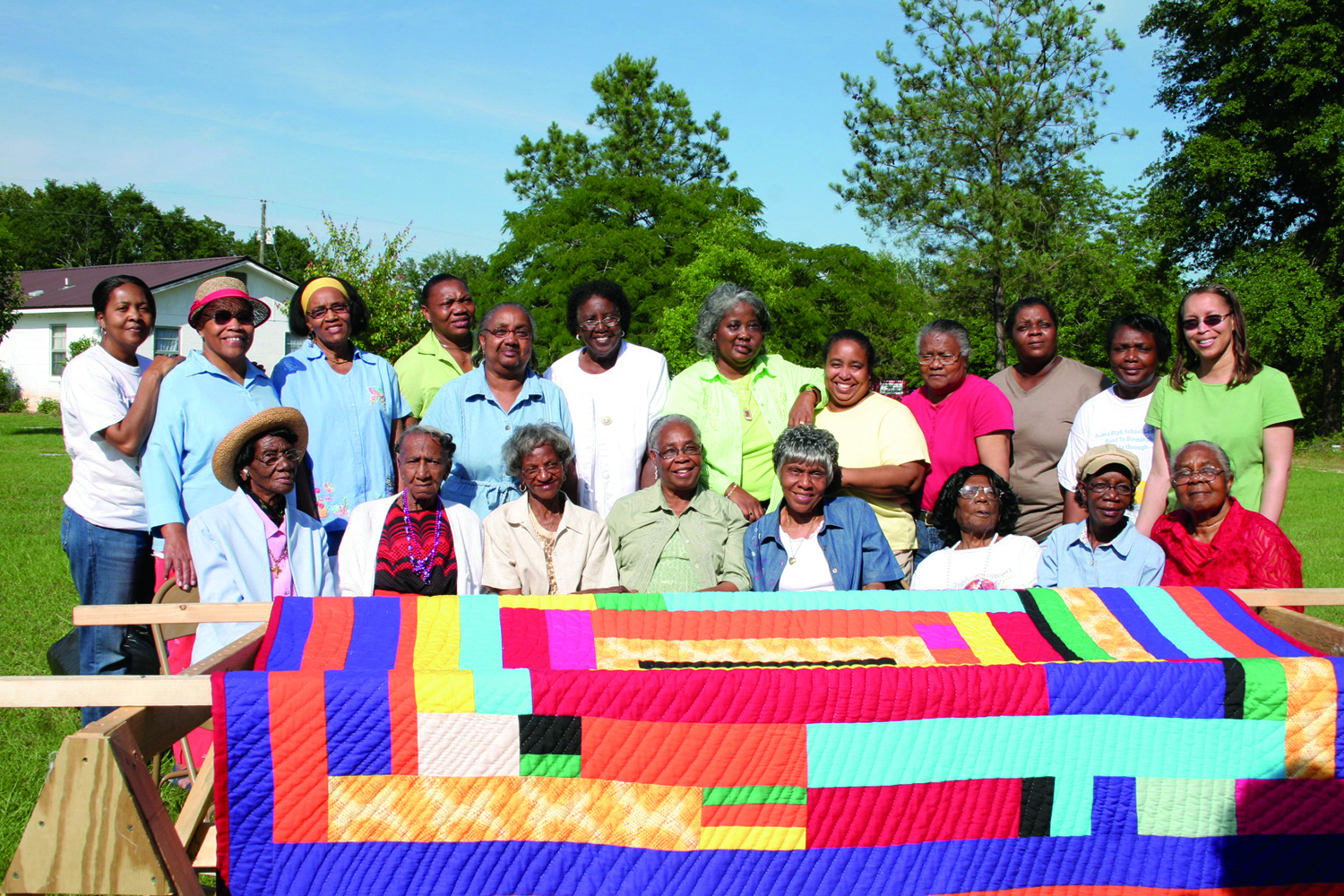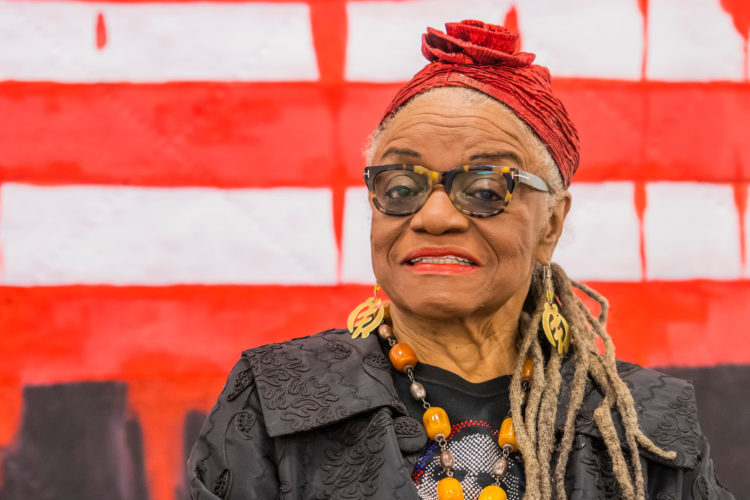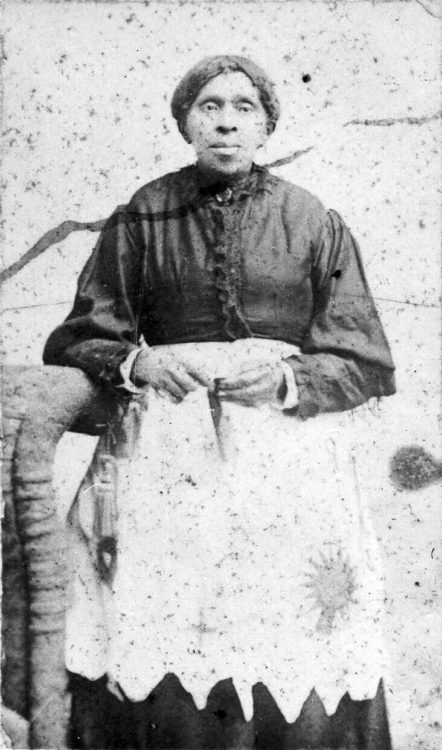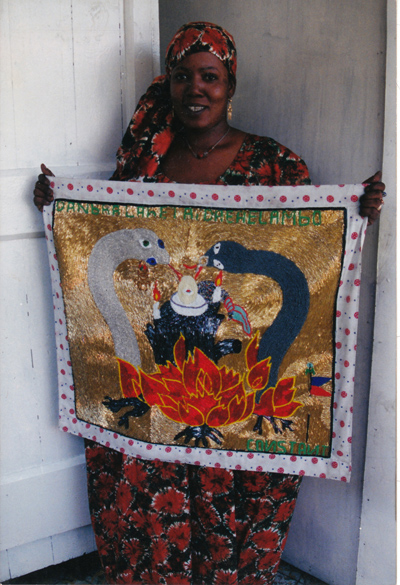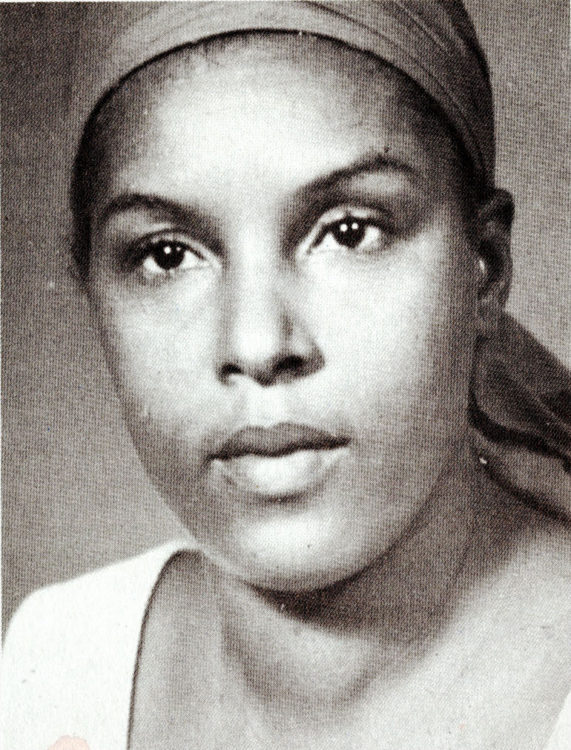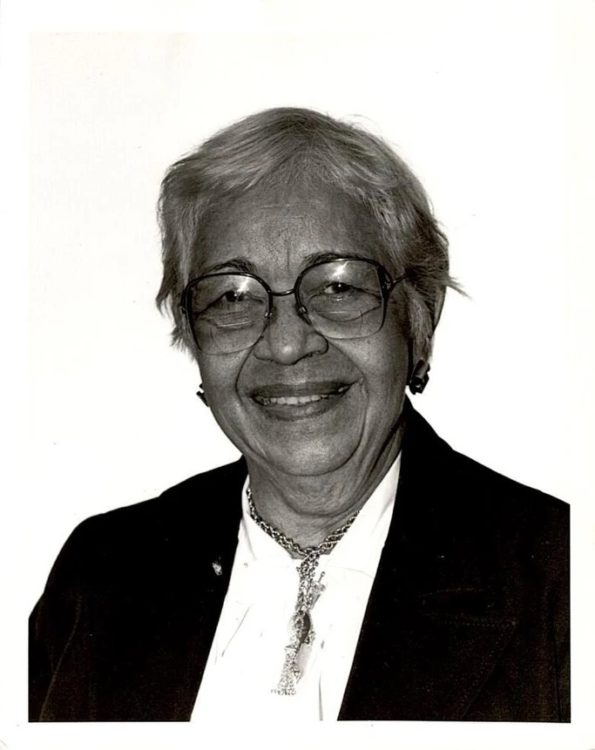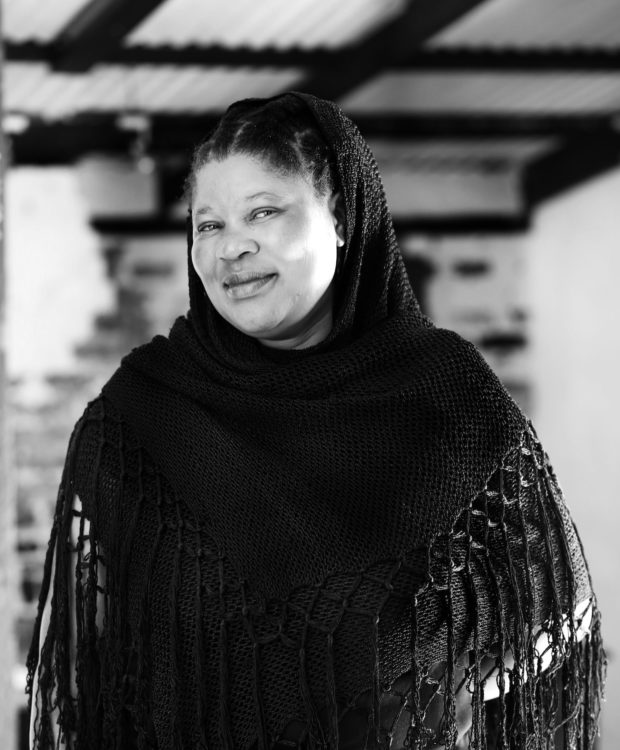Research
Since the nineteenth century, in the small town in Alabama known as Gee’s Bend1 or Boykin, in the South of the United States, women from the Gee’s Bend community have practised and passed down the art of quilting. This technique involves carefully stitching together pieces of fabric to create quilts, composed of at least two layers of material enclosing a layer of padding. Most often, they are made from fabric scraps or repurposed used clothing. In nineteenth-century North America, quilting was practised by women from across the social spectrum, and was often a collective activity. Like Harriet Powers (1837–1910), a quilter from the neighbouring state of Georgia, the Gee’s Bend community has woven a unique strand in the American quilting story, and its artists’ works represent an important contribution to African-American art.
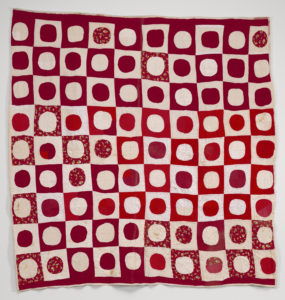
Lucy T. Pettway, Snowball, c. 1950, cotton, corduroy, cotton sacking material, 85 × 83 in. (215.9 × 210.8 cm), Virginia Museum of Fine Arts, Adolph D. and Wilkins C. Williams Fund and partial gift of the Souls Grown Deep Foundation.
In 2002, the quilters’ work would be discovered by the general public, via The Quilts of Gee’s Bend, an exhibition opening in September of that year at the Houston Museum of Fine Arts, and which travelled on to the Whitney Museum of American Art in New York that December. The exhibition, which was later hosted in twelve more towns in the United States, marked the beginning of institutional recognition for the women, who saw their quilts hung on the walls of some of the country’s most renowned museums. The quilts were displayed without images of the artists and with little contextual explanation2; like this, the public was allowed to concentrate on the works themselves. At the exhibition’s closing in 2006, it had received almost 200,000 visitors. Today, around thirty museums have Gee’s Bend quilts in their collections, evidence of their important place in art history and their continued influence on numerous contemporary artists.3

Exhibition view, The Quilts of Gee’s Bend, Whitney Museum of American Art, New York (21 November 2002 – 9 March 2003), © photo: Jerry L.Thompson.
The families living at Gee’s Bend descend from enslaved people who worked on the cotton plantation there. At the end of the American Civil War in 1865, with the abolition of slavery, inhabitants found themselves in a condition of extreme poverty. Abandoned by the state, families continued to cultivate the cotton fields, and still live today in modest conditions. The purchase of the land by the federal government in the 1930s enabled the community to retain the right to use its land and homes, at a time when many African-Americans were leaving the rural southern states, between 1910 and 1970, to find work in the northern cities (the Great Migration). In the 1960s, the Gee’s Bend community participated in the civil rights movement, galvanised by a visit from Martin Luther King Jr. to their isolated part of Alabama. However, the community would pay a heavy price. In retaliation, the government cut off the ferry system that traversed the Alabama River and linked Gee’s Bend to the rest of the state.
We can see, then, that quilting has long played an essential role in the rural community of Gee’s Bend. This artisanal and artistic practice has now traversed four to five generations of women, passed on from mother to daughter, grandmother to granddaughter, aunt to niece. The quilts were not originally conceived as artworks by their creators but as a useful and creative pastime, and instead came to be considered art bit by bit, over time, as institutions began to show interest. They bear witness to community life, testifying to important moments in a collective history as well as to more intimate stories. Sometimes, they acquire a spiritual dimension, such as when fabricated from the clothes of deceased community members: a spouse, a parent, brothers and sisters. In the early 1940s, Missouri Pettway (1902–1981) and her daughter Arlonzia Pettway (1923–2008) constructed a quilt from the workwear of their husband and father, Nathaniel, thus conserving and uplifting the only possessions of the deceased man.
“You can see the struggle, you can see the joy, you can see sadness, happiness, all those different emotions in those quilts” Loretta Pettway Bennett (1960–).4
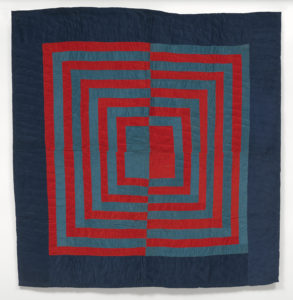
Rita Mae Pettway, Housetop, 1977, corduroy, 80 × 76 in. (203.2 × 193 cm), Virginia Museum of Fine Arts, Adolph D.and Wilkins C. Williams Fund and partial gift of the Souls Grown Deep Foundation.
Let us now turn to the works’ motifs and materials. Their particularity resides primarily in their audacious colour juxtapositions, the variety of fabrics used and the asymmetry of their designs. Historically, most quilts were constructed from used clothes, notably denims (worn for working in the fields) for the winter, and cotton dresses, blouses, aprons and shirts for the warmer months.5 Beginning in the 1950s, however, certain suppliers began to send the quilters new fabrics.
Quilt designs are often passed down and reimagined from generation to generation: among the most popular, for instance, is the Housetop, a simple motif formed of concentric squares. Mary Lee Bendolph (1935–), one of the most respected members of the community, created a particularly fine red and brown Housetop in 1998 from old, unfashionable clothes that no one wanted to wear.
“I didn’t get no schooling – every now and then a day here and there. Didn’t nobody teach me to make quilts. I just learned by myself, at about twelve or thirteen. I was seeing my grandmamma piecing it up, and then I start. I just taken me some pieces and put it together, piece them up till they look like I want them to look. That’s all.” Mary Lee Bendolph6

Mary Lee Bendolph, Housetop, 1998, cotton corduroy, twill, assorted polyesters, 74 × 74 in. (188 × 188cm), The Phillips Collection, museum purchase and gift of the Souls Grown Deep Foundation.
Another design, the Pinwheel, consists of several triangles in contrasting colours. Essie Bendolph Pettway’s (1956–) floral green and blue Pinwheel, dating from 2000, uses fabric scraps from dresses she made for herself and her mother, piecing together a portrait of two generations. Essie Bendolph Pettway is the daughter of Mary Lee Bendolph, and one of the first quilters in the community to describe herself as making quilts solely for recreational and aesthetic reasons. Having worked for many years in a military clothing factory in Selma, where she spent at least fifteen hours each week driving to and from work, every late afternoon on returning home she nevertheless turned immediately to her own sewing machine to take up her quilting.
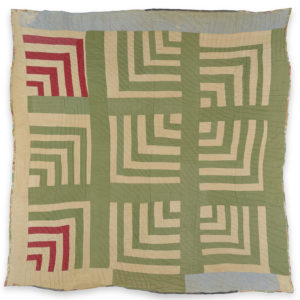
Rita Mae Pettway, “Housetop” – nine-block “Half-Log Cabin” variation, c. 1945, corduroy, 182.9 × 182.9 cm, Souls Grown Deep Foundation , Atlanta, © Estate of Martha Jane Pettway / ARS, NY and DACS, London 2022, © photo: Stephen Pitkin / Pitkin Studio.
In 1966, several women in the community founded The Freedom Quilting Bee, a cooperative intended to organise the production and sale of the quilts which was active until 2012. The growth of national and international recognition for the artists of Gee’s Bend, however, remains intimately linked with the Souls Grown Deep Foundation, which was started by the US collector William Arnett. First visiting Gee’s Bend in 19977, Arnett became fascinated by African-American folk art in the Southern States8. The foundation would facilitate the collection of community members’ biographies, along with the sale of many of their works. In 2007, however, Annie Mae Young (1928–2013), Lucinda Pettway Franklin (1957–) and Loretta Pettway (1942–) took legal action against the Arnett family for the theft of their intellectual property rights, calling into question the foundation’s model, a model on which most of the museums that have exhibited the works of the Gee’s Bend Quilt Collective have relied.
Like much textile art, little attention has been paid to the quilt in art history, seen as it is as utilitarian9 and, as a product of the domestic space, feminine: thus it is situated in the well-entrenched dichotomy established between the fine arts and the decorative arts. Academia arrived late to the history of African-American quilting, in the mid-1970s.10 As with many artists whom Western art history struggles to comprehend, for a long time institutions focused solely on the living conditions of the Gee’s Bend community – the creators were first and foremost described as Black women from the South, lacking qualifications, extremely modest – rather than on their artistic production.
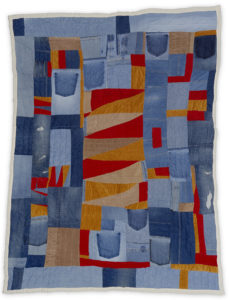
Marlene Benett Jones, Triangles, 2021, denim, corduroy, and cotton, 205.7 × 157.5 cm, Souls Grown Deep Foundation , Atlanta, © 2023 Marlene Bennett Jones / Artists Rights Society (ARS), New York / DACS, London, © photo: Stephen Pitkin / Pitkin Studio
However, numerous African-American contemporary artists have acknowledged the quilt, crediting its place in their visual culture. Willie Posey Jones (1903–1981), fashion designer and mother of artist Faith Ringgold (1930-2024), would teach her daughter the art of patchwork and quilting, with F. Ringgold going on to create works that paid homage to major African-American figures: Martin Luther King Jr., James Baldwin, Audre Lorde and Harriet Tubman, among others. She would also use the medium to explore memories of her childhood in Harlem in a series of quilts beginning in 1988, entitled Woman on a Bridge.
Between 17 March and 18 June 2023, several quilts from the Gee’s Bend Collective were displayed at the Royal Academy of Arts exhibition Souls Grown Deep like the Rivers (Black Artists from the American South) in London. The works of the Gee’s Bend Quilt Collective, however, remain little exhibited and studied outside the borders of their country, even though textile arts are gaining visibility everywhere and that the practice of quilting spreads within the Black Atlantic (Quilts of the community of Mampuján, Colombia).
List of Gee’s Bend quilters (122):
Lucy Mooney (circa 1880–1969)
Joerina Pettway (circa 1881–1945)
Gertrude Miller (1884–1970)
Maggie Benning (1891–1985)
Delia Bennett (1892–1976)
Henrietta Pettway (1894–1971)
Hannah Wilcox (1896–1973)
Rebecca Myles Jones (circa 1896–1986)
Willie “Ma Willie” Abrams (1897–1987)
Magdalene Wilson (1898–2001)
Patty Ann Williams (1898–1972)
Martha Jane Pettway (1898–2003)
Girlie Irby (circa 1898–1955)
Annie Bendolph (1900–1981)
Mary Ann Pettway (1900–1953)
Jennie Pettway (1900–1990)
Missouri Pettway (1902–1981)
Minder Coleman (1903–1999)
Sweet T. Pettway (1903–1983)
Annie E. Pettway (1904–1972)
Clementine Kennedy (1904–1974)
Ella Bendolph (1904–1985)
Della Mae Bridges (1905–2000)
Pearlie Pettway Hall (1908–2000)
Rachel Carey George (1908–2011)
Lottie Mooney (1908–1992)
Arie Pettway (1909–1993)
Ethel Young (1910–2000)
Mary Elizabeth Kennedy (1911–1991)
Martha Pettway (1911–2005)
Aolar Carson Mosely (1912–1999)
Indiana Bendolph Pettway (1913–1996)
Amelia Bennett (1914–2002)
Malissia Pettway (1914–1997)
Lottie Pettway (1914–1997)
Nell Parker Pettway (circa 1914–1981)
Seebell Kennedy (1915–1981)
Nettie Jane Kennedy (1916–2002)
Liza Jane Williams (1916–1988)
Deborah Pettway Young (1916–1997)
Estelle Witherspoon (1916–1998)
America Irby (1916–1993)
Nettie Young (1916–2010)
Margaret Bennett (1916–1994)
Allie Pettway (1916–2010)
Mertlene Perkins (1917–2015)
Ruby Gamble (1918–2001)
Plummer T. Pettway (1918–1993)
Gearldine Westbrook (1919–2016)
Agatha P. Bennett (1919–2006)
Irene Williams (1920–2015)
Pearlie Kennedy Pettway (1920–1982)
Lucille Bennett Pettway (1921–1999)
Lucy T. Pettway (1921–2004)
Louella Pettway (1921–2006)
Sue Willie Seltzer (1921–2010)
Lizzie Major (1922–2011)
Polly Bennett (1922–2003)
Ella Mae Irby (1923–2001)
Arlonzia Pettway (1923–2008)
Joanna Pettway (1924–1993)
Candis Pettway (1924–1997)
Lutisha Pettway (1925–2001)
Marie Pettway (1926–1987)
Ruth Kennedy (1926–2020)
Eddie Lee Pettway Green (1926–)
Minnie Sue Coleman (1926–2012)
Creola Bennett Pettway (1927–2015)
Lillie Mae Pettway (1927–1990)
Willie Ann Benning (1927–)
Emma Lee Pettway Campbell (1928–2002)
Annie Mae Young (1928–2013)
Ruth Pettway Mosely (1928–2006)
Beatrice Pettway (1928–1988)
Jessie T. Pettway (1929–)
Linda Pettway (1929–2012)
Leola Pettway (1929–2010)
Annie Bell Pettway (1930–2003)
Lucy P. Pettway (1930–2003)
Addie Pearl Nicholson (1931–2022)
Emma Mae Hall Pettway (1932–2021)
Nell Hall Williams (1933–2021)
Sarah Benning (1933–)
Arcola Pettway (1934–1994)
Mary Lee Bendolph (1935–)
Nancy Pettway (1935–)
Sadie Bell Nelson (1936–1981)
Aestean P. Young (1936–2001)
Queen Hall (1938–2015)
Helen McCloud (1938–)
Bettie Bendolph Seltzer (1939–2017)
Mensie Lee Pettway (1939–)
Nellie Pettway (1940–)
Lola Pettway (1941–2022)
Rita Mae Pettway (1941–)
Loretta Pettway (1942–)
Mary L. Bennett (1942–)
Qunnie Pettway (1943–2010)
Sally Bennett Jones (1944–1988)
Nellie Mae Abrams (1946–2005)
Marlene Bennett Jones (1947–)
Nazareth Major (1947–2020)
Florine Smith (1948–2022)
Mary Spencer (1949–2017)
Katie Mae Pettway (1950–)
Edwina Pettway (1950–)
Flora Moore (1951–)
Lue Ida McCloud (1951–)
Stella Mae Pettway (1952–)
China Pettway (1952–)
Lucy L. Witherspoon (1953–)
Lorraine Pettway (1953–)
Linda Diane Bennett (1955–1988)
Gloria Hoppins (1955–)
Essie Bendolph Pettway (1956–)
Lucinda Pettway Franklin (1957–)
Belinda Pettway (1957–2021)
Vera Pettway Major (1959–2022)
Louisiana P. Bendolph (1960–)
Loretta Pettway Bennett (1960–)
Annette Pettway (1964–)
Sally Mae Pettway Mixon (1965–)
Andrea Williams (1973–)
The name ‘Gee’s Bend’ comes from Joseph Gee, who bought the land in 1816 to establish a cotton plantation, where he put to work a dozen enslaved people.
2
Duncan, Sally Anne, “From Cloth to Canvas: Reinventing Gee’s Bend Quilts in the Name of Art”, Museum Anthropology, vol. 28, no 1, March 2005, p. 19-34, https://doi.org/10.1525/mua.2005.28.1.19.
3
Faith Ringgold, Clementine Hunter, Wini McQueen, Chris Clark, Romare Bearden and Rosie Lee Tompkins, to name just a few.
4
Loretta Pettway Bennett, in Hessel, Katy, The Story of Art without Men, London, Hutchinson Heinemann, 2022, p. 323.
5
Mark Scala, Creation Story: Gee’s Bend Quilts and the Art of Thornton Dial, exh. cat., Frist Center for the Visual Arts, Nashville (25 May–3 September 2012), Nashville, Frist Center for the Visual Arts, 2012.
6
Mary Lee Bendolph, in Creation Story: Gee’s Bend Quilts and the Art of Thornton Dial, exh. cat., Frist Center for the Visual Arts, Nashville (25 May–3 September 2012), Mark Scala, Nashville, Frist Center for the Visual Arts, 2012, p. 38.
7
Duncan, Sally Anne, “From Cloth to Canvas: Reinventing Gee’s Bend Quilts in the Name of Art”, Museum Anthropology, vol. 28, no 1, March 2005, p. 19-34, https://doi.org/10.1525/mua.2005.28.1.19.
8
William Arnett has acquired five hundred quilts from the Gee’s Bend community, and is also a major collector of the works of the artist Thornton Dial (1928–2016).
9
Hessel, Katy, The Story of Art without Men, London, Hutchinson Heinemann, 2022.
10
Hicks, Kyra E., Black Threads: An African American Quilting Sourcebook, Jefferson / London, McFarland & Co., 2003.
Aby Gaye-Duparc examines the trajectories of women of African descent in Europe and North America from the 1960s to the 2000s, as they can be mapped out within the space known as the “Black Atlantic”. Having served as International Development Coordinator for the Friends of the Centre Pompidou (2019–2021), and notably in the acquisition group for Africa, she is currently Artistic Project Coordinator at the Fondation Cartier. In 2021, she cofounded the AWU feminist library in Dakar.
A article produced as part of “The Origin of Others” research programme, in partnership with the Clark Art Institute.
Aby Gaye-Duparc, "The Gee’s Bend Quilt Collective: a story of the South." In Archives of Women Artists, Research and Exhibitions magazine, . URL : https://awarewomenartists.com/en/magazine/le-gees-bend-quilt-collective-une-histoire-du-sud-des-etats-unis/. Accessed 9 July 2025
